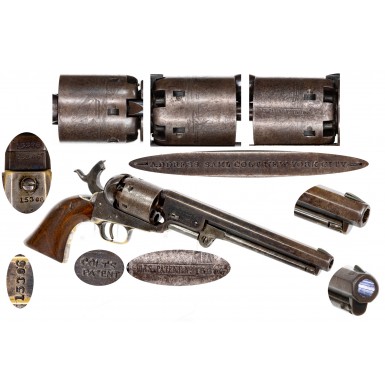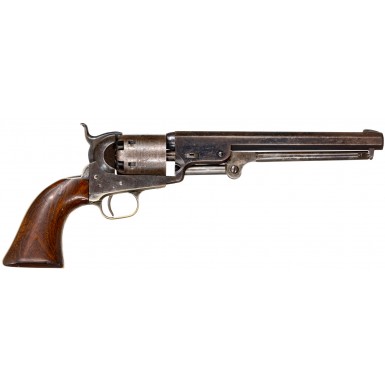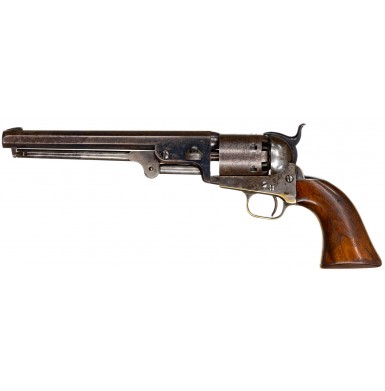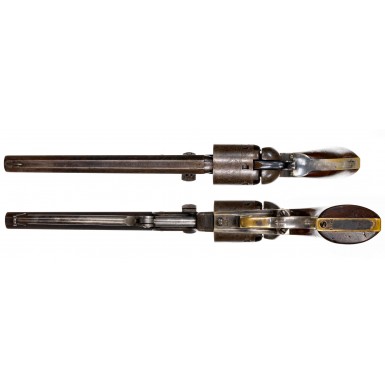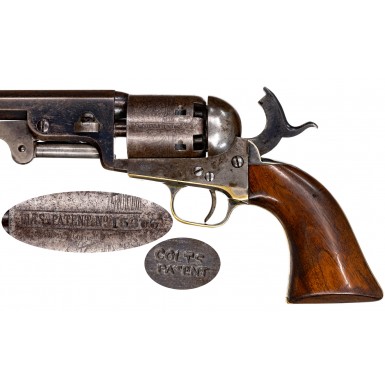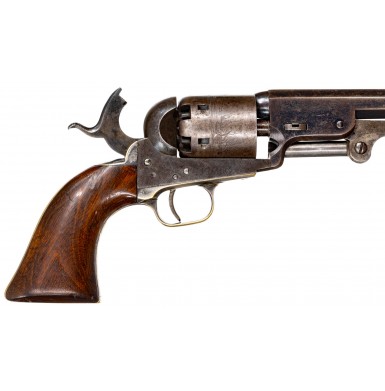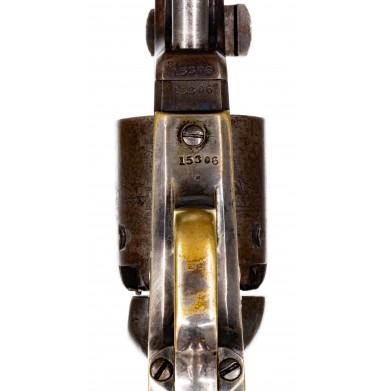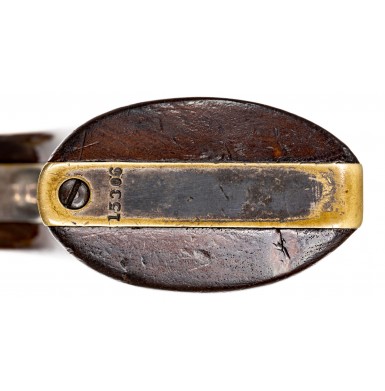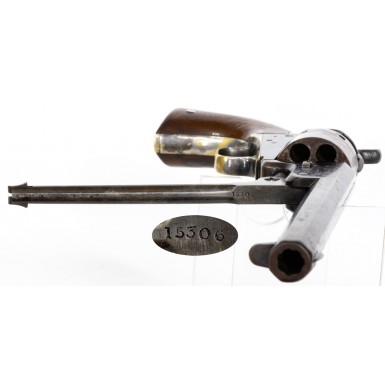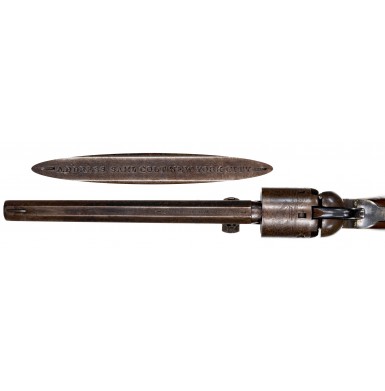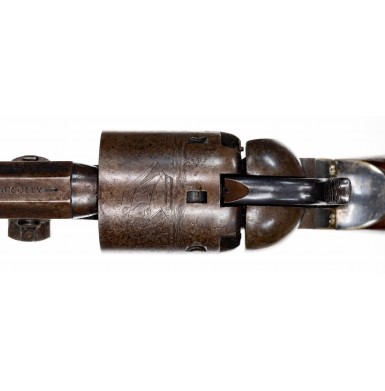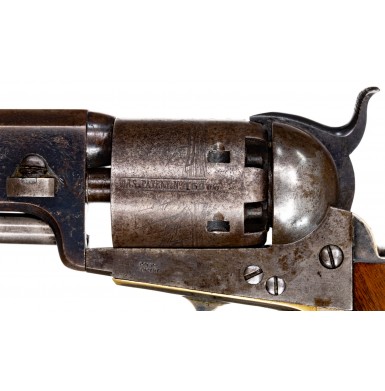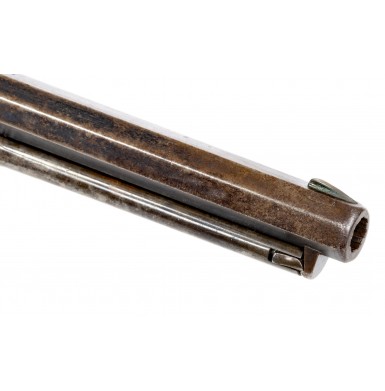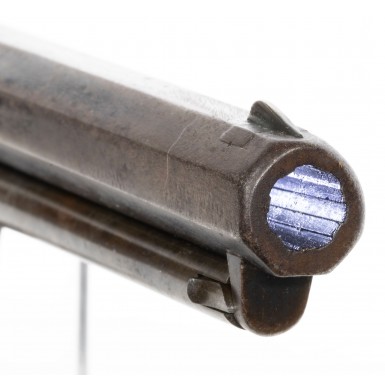Fine Early 3rd Model Colt Model 1851 Navy Revolver
- Product Code: FHG-3486-SOLD
- Availability: Out Of Stock
-
$4,250.00
Next to the Model 1873 Colt Single Action Army revolver, there is probably no Colt revolver that is more iconic than the Colt “Belt Model”, better known to collectors as the Mode 1851 Navy percussion revolver. The revolver was introduced by the famous Colt Patent Arms Manufacturing Company in 1850 and remained in production through 1873, when Colt’s new self-contained cartridge revolvers finely made the percussion revolver obsolete. During its production life, Colt produced 215,348 of the legendary handguns in Hartford, CT, not counting those produced in London, with some 175,000 or so being produced prior to the end of the American Civil War.
The percussion revolver was .36 caliber, with a 7 ½” octagonal barrel and a six-shot cylinder. The action was Colt’s tried and true single action lock work, and the gun was made in two primary sections, with a removable wedge securing the barrel and loading lever assembly to the cylinder arbor and frame. The standard finish was a blued barrel with a color casehardened frame, hammer and loading lever. The backstrap and triggerguard were usually produced of brass with silver plating, but some examples were made with iron backstraps and triggerguards and some were even made with iron backstraps and brass triggerguards. Standard grips were one-piece varnished walnut for commercial guns, while most military contract guns had oiled walnut grips. Like any Colt product, a wide variety of upgrades and options were available to the customer, limited only by the buyer’s budget and imagination. Grips made from exotic materials, most often ivory, were available, and these could be checkered or carved, with other options such as exotic woods available as well. Upgraded finished could include silver and gold washes, nickel plating, full blue and combination finishes of silver plating and blue. Engraved and highly embellished guns were available as well. The Navy was one of the revolvers that Colt offered from time to time with a detachable shoulder stock, and even front sight options were available to the buyer.
Many fighting men of the era considered the “Navy” to be the perfect combination of size, weight, firepower, and overall ergonomics. The advocates for the pistol ranged from pistoleros like “Wild Bill” Hickok, to Confederate cavalry Generals like J.E.B. Stuart and Nathan Bedford Forrest. It is interesting to note that most Confederate produced revolvers were essentially copies of the Colt “Navy”, and not the more powerful .44 caliber Colt “Army” revolver, and even those that were not direct Colt clones tended to retain the .36 caliber chambering. Thousands of these revolvers were used by both US and CS soldiers during the Civil War. Not only those guns that were purchased on US government contracts saw the battlefield, but also many acquired on the open market both before and during the war saw service. Many commercial guns ended up in the hands of combatants on both sides during the course of the war.
Like most of Colt’s firearms that survived in the product line for more than a couple of years, the 1851 Navy went through a number of design and engineering changes and upgrades during its lifetime. Collectors and researchers have categorized these guns into four “models” from 1st through 4th and then further subdivided the categories into “early”, “middle” and “late” production for the 3rd and 4th model guns. Nominally by serial number the “1st Model” guns appear in the #1-#1,250 range, with the 2nd Model guns appearing in the #800-4,581 range. These 1st and 2nd Model guns are instantly recognizable by their “Square Back” triggerguards similar to the profile of those used on the 1st and 2nd Model Dragoon revolvers and most of the Model 1848 Baby Dragoon handguns. There are some minor differences between the 1st and 2nd Models, most notably the location of the barrel wedge, which is above the screw and enters from the right side on the 1st Model guns and is below the screw and enters from the left on the 2nd Model guns. Other changes are minor and not visible without disassembly. Early 3rd Model revolvers started to appear around #3,620 and run through about #30,520 with Middle 3rd Model revolvers appearing in the #30,250-#39,500 range and the Late 3rd Models appearing in the #37,572-#85,472 range. The 3rd Model guns are instantly recognizable by their small brass triggerguards, with the other improvements and changes being minor machining changes in things like the shape of the cut out in the barrel web for the loading groove and some minor changes in the size of some parts, like the barrel lug. The Early 4th Model guns appear around #85,921 and run through about #118,586. The most noticeable change from the 3rd Model guns is the introduction of the large brass triggerguard, replacing the small brass guard typical of 3rd Model guns. The Early 4thModel revolvers also introduced the Hartford barrel address for the first time, as all previous M1851s had utilized a New York barrel address. The Hartford address remained in use through most of the Early 4th Model production but was changed back to a New York address in the #98,000 to #101,000 range. These guns appear in the rough range of #118,000 to #168,000. The primary difference between the Early and Middle 4th Model guns is the addition of the capping groove in the capping cut-out of the recoil shield. Late 4th Model guns appear start to appear in the #166,000 range and continue through the end of production. The primary difference here is the change in the way small parts are knurled and the way in which serial numbers are applied to various parts. Through all these changes, the basic gun changed not at all, but most of the changes and improvements were adopted to either make the guns more ergonomic in operation or to streamline and improve production. The categorization by serial number range used above is from the detailed research of Robert Jordan and Don Geri published in their book Colt 1851 and 1861 Navies & Conversions. This is a fine resource for those who want to find out more details regarding some of the more minute feature and design changes between the various “models” of 1851 Navy revolvers.
Offered here is a scarce example of an Early 3rd Model Colt Model “Navy” Revolver. The gun is serial number 15306, placing its production sometime in mid-1852, making it a fairly early gun. Records indicate that the 1851 Navy serial numbers ran from approximately 10,000 to 20,000 during 1852. The gun remains in about FINE condition and is quite crisp throughout. The gun has the expected 3rd Model features of small serial numbers, the small loading cut out in the front right of the frame like the earlier 1st and 2nd Models, the thin loading lever catch and the traditional small brass triggerguard that typifies 3rd Model production. The top flat of the barrel is clearly roll-marked in a single line:
− ADDRESS COL. SAML COLT NEW-YORK CITY –
The barrel address is clear and crisp and does not show the broken lower right corner of the “N” in “New” that is encountered later during 3rd Model production. As noted, the gun is serial numbered 15306 with the correct Colt numbering dies of that era, placing production in 1851. The cylinder is roll-marked COLT’S PATENT No 15306 with a weak WL Ormsby signature below the Colt’s Patent box. The Ormsby signature remains partially visible and legible but is not very strong. The small Ormsby signature disappears from Colt Navy cylinder roll scenes somewhere around the upper portion of the 78,XXX serial number range. It is a nice feature to find on an early gun. The numbers are all matching throughout, including the wedge. The one-piece varnished walnut grip is ink numbered 5306 in the backstrap cut out, in a bold period hand and remains fully legible. The revolver is crisply and clearly marked on the lower left side of the frame, COLTS / PATENT, and with a tiny B inspection mark on the front left web of the triggerguard and a larger T on the right rear edge of the triggerguard plate. A tiny X is stamped on the bottom of the triggerguard plate, between the serial number and front bow of the triggerguard. An 8 is also stamped above the serial number on the bottom of the barrel web.
As previously noted, the gun is in FINE condition. The barrel retains about 40% of its original bright blued finish with the loss apparently due to holster wear and flaking. The barrel surface is free of any real pitting, but there is some lightly scattered pinpricking present on the metal and some oxidized freckling and light pitting present on the face of the muzzle and in the last inch or so closest to the muzzle and the forcing cone. The pistol shows only some very light impact marks on the barrel web where the wedge had been beaten out of the pistol during its service life, and then beat back into place. Normally these marks are far more prominent. The loading lever retains about 20% of its original case coloring, most of which has faded and dulled. It has a mottled gray and dark gray patina that suggests the original coloring in the areas that retain no mottled colors. The lever is numbered 15306, matching the gun. The loading lever moves smoothly and operates correctly and locks tightly into place, as it should. The frame of the revolver retains about 10%-20% of its original case coloring which has faded and dulled and is mostly muted. The balance of the frame has a mottled dark gray and brown patina that mimic some of the original mottled patterns. The frame also show some scattered oxidation with freckles of age discoloration and some very minor pinpricking on its surface. The cylinder retains only some minute traces of its original blue and has a moderately oxidized plumb brown and dark gray patina with freckles of darker age discoloration and some surface roughness. The cylinder remains very sharp and crisp and retains 85%+ of the roll engraved scene. The Mexican War naval battle scene engraved on the cylinder rates FINE, and nearly all of the scene remains crisp and clear. As noted, this early production cylinder includes the Ormsby signature line as found on some high condition guns produced prior to mid-1857. The legend at the front edge of the cylinder that reads ENGAGED 16 MAY 1843 is no longer visible. This mark is rarely legible, or even visible, it is not uncommon that it is gone. All the cones (nipples) in the cylinder appear to be original and they all show moderate wear and erosion from the corrosive percussion caps. There is also some light pitting on the face of the cylinder from firing and use. The safety pins on the rear face of the cylinder are moderately worn and battered with only one remaining relatively crisp, three showing moderate battering and wear and two showing only traces of their original presence on the rear of the cylinder. The silver-plated brass grip frame, grip strap and triggerguard retain about 50%+ their original silver plating which shows a moderately tarnished, dark gray patina. The quality of the plating on the early Colts was quite good allowing the silver to survive in fairly nice condition on some of these very early guns. The action of the revolver is very good, and the gun functions correctly, timing, indexing, and locking up very tightly. The action of the pistol still remains quite crisp. All of the screws appear to be original. The screws remain fairly crisp and only a couple show any real slot wear. Good screws are fairly uncommon for a gun of this age. The bore of the revolver is in about VERY GOOD condition. It is mostly bright with moderate amounts of scattered oxidation and retains strong rifling along its entire length. The bore also shows some lightly scattered pitting along its length. The gun has a relatively scarce factory dovetailed “Rocky Mountain” front sight blade, rather than the more common brass bead or cone. While never really listed as a factory option, the survival of a small number of dovetailed front sight guns suggest that a customer could order a Model 1851 Navy revolver with such a blade sight installed. The factory dovetailed front sights start to appear on Colt Navy revolvers during the early 3rd Model production period. The civilian style, narrow one-piece “Slim Jim” varnished walnut grip is in about VERY GOOD condition to NEAR FINEcondition. As noted, it is numbered to the revolver and fits the frame of the gun perfectly. The grip retains only traces of its original varnish and may have been very lightly sanded long ago as the sharp edges are slightly rounded. The grip is solid free of any breaks, cracks, or repairs. Although it remains in nice condition, the grip does show some moderate wear along the sharp edges and high points. As is often the case, the very sharp points at the leading and trailing edges of the bottom of the grip are worn and rounded. Otherwise, the grip shows only the expected handling marks, surface mars and dings from carry and use.
Overall, this is a very nice condition, well-marked and crisp example of a very early production Colt Early 3rd Model 1851 Navy Revolver. The gun was produced in mid-1852 and has a low five-digit serial number, making it attractive addition to a serious Colt Navy collection that needs an early production gun. 1852 produced Colt Navies don’t appear for sale very often and this is a crisp, correct, and original example that appear to have all of the parts that it had when it left the Colt factory some 170 years ago. This is a lot of Colt revolver for a very fair price, particularly for a low number, 1852 production revolver that retains some nice original finish.
SOLD
Tags: Fine, Early, 3rd, Model, Colt, Model, 1851, Navy, Revolver

